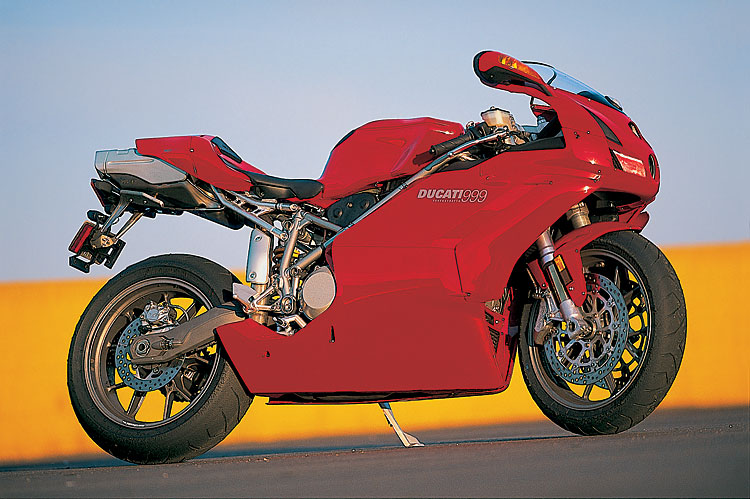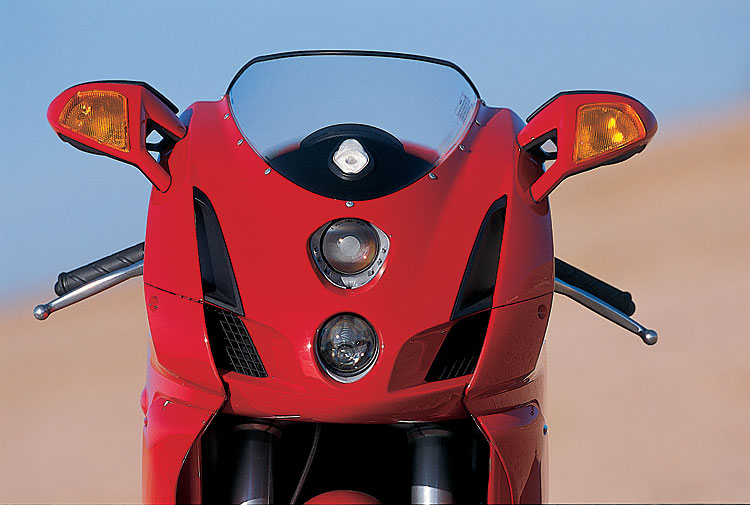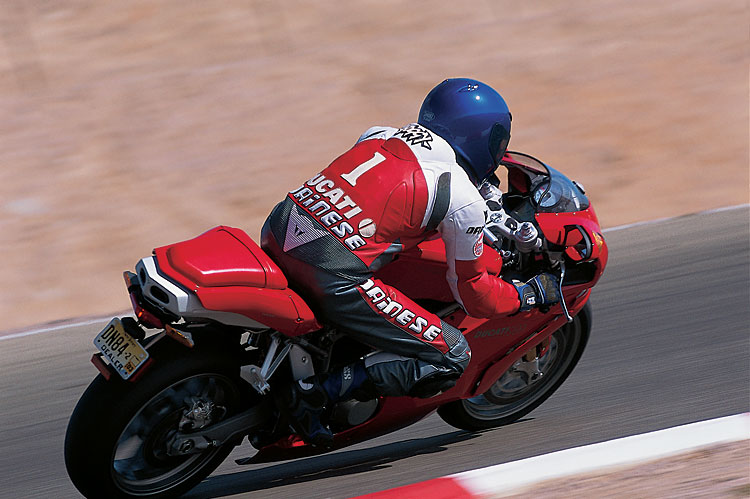Ducati 999

It had to supercede the other bikes in design, technology, and in performance characteristics on the track and on the street. And now, coming on the heels of its famous 916/996/998-line, Ducati's new 999 is destined to become a great bike that's known for kicking butt and taking no prisoners.
Concept & Tranformation
Did anyone else want to be in Pierre Terblanche's skin, shackled with the gargantuan task of creating a new benchmark bike after the 916? Probably not. There couldn't have been a more difficult job out there then. At the Milan show in 1993, design guru Massimo Tamburini presented a bike with outstanding looks and performance, the 916 (S), which went on to dominate the motorcycle world for almost a decade. Its successors, the 996 (model year 1999) and the 998 (in 2002), are two of the most desirable bikes to consider for the serious outlay of cash it takes to acquire them, and they still used the same narrow front fairing and the typical rear section with two mufflers underneath as in the 916.
But Terblanche did his job, and he did it well. Creating a new Ducati Superbike look, his colleagues from the R & D department threw in a whole bunch of technical features which are certain to mark a new era in the company's history. To one and all, even that traditional group of hesitant Ducati fans, all we can say is, "Run, don't walk, to the nearest dealer and simply look at it." None of the pictures - not even ours - do it justice.

Engine & Transmission
The only thing Ducati took over from its predecessor, the 998, is the well-known Testastretta engine. "Testastretta" means "narrow head" because of the new dimensions of the top end. Narrower valve angles and more compact combustion chambers with flat top pistons create this shape. A higher compression ratio (11.4:1), bigger valves (intake 40mm, exhaust 33mm), bigger bore (100mm), shorter stroke (63.5mm) and 54-mm throttle bodies instead of 50mm ones are further improvements over the 996.
For the 999, Ducati added a new exhaust system with an innovative non-symmetrical layout. It uses pipes of different length and diameter. The front pipe increases from 45 to 55mm underneath the engine; the rear runs a constant 45-mm diameter to the high-volume single muffler. By varying the diameters, Ducati equalizes pulse waves and back pressure. Two catalytic converters - one for the front pipe underneath the engine, one for the rear right before the muffler - easily meet the tight Euro 2 standards for Europe.

Another change compared to the 998 is the airbox. The gas tank is no longer at the top of it, and the volume of the airbox has increased to 12.5 liters. Also, the air-intake tracts incorporate Helmholtz resonators to reduce intake noise without sacrificing performance. All this results in more midrange power and torque between 4,500 and 7,000 rpm. The top-end measurements remained the same: 124 hp at 9,750 rpm and 75.3 ft-lbs. at 8,000 rpm. At the test session in Willow Springs, the 999 impressed with good steady power output over a wide rpm range. The rev limiter kicks in at 10,500 rpm (after the first service at 600 miles) and reminds you of switching gears in the short-shifted six-speeder with close ratios. There are two shift signals on the instrument panel, one at 100 rpm and one at 200 rpm before hitting the limiter.

Although Ducati doesn't beat the Dyno numbers of their competitors with the standard 999, the Testastretta engine is still outstanding. It's easy to operate, runs very smoothly, and has very little vibration - V-twin at its best. Power-wise, the 999S issues a challenge for the other European and Japanese manufacturers of V2s to meet. It makes 136 hp at 9,500 rpm and 80 ft-lbs. at 8,000 rpm. The standard 999 set up gives you more than enough power output for public roads and for fun on the track.
Chassis & Brakes
The first thing that attracts your eyes when looking at the 999 is the sand-cast aluminum, double-sided swingarm. Compared to the former single-sided-version of the 916, 996 and 998, it is stiffer without increasing weight. Also, the swingarm is longer which increases the wheelbase by 10mm to 1,420mm. Two horizontal sliders, allowing adjustment without changing the ride height, maintain chain tension.

To offer an aerodynamic and comfortable riding position, Ducati narrowed the tubular-steel cage frame in the section between the rider's legs. The front fork rake is the same as on the 998 and is adjustable from 65.5 to 66.5 degrees. In this case, the trail changes from 97 to 91mm. Because of the specially designed eccentric adjustment in the steering head, the wheelbase remains the same.
The 43mm upside-down fork in the front, from Showa (999S: Öhlins), is titanium-nitride coated to reduce friction. Like the rear shock (Showa; 999S: Öhlins), it is fully adjustable. Additionally, the shock has a unique rod setup to allow adjustment of the ride height. For rigidity and precise handling, the hollow front axle measures 25mm in diameter. The front brake uses the same four-pot/four-pad calipers found on the 998. They work great, and the feel got even better with a new 18mm radial-pump master cylinder installed. As in the radial one for the clutch, it is exclusively made for Ducati by Brembo to allow increased steering lock angle and a lower front fairing. The size of the rear disc increased from 220 to 240mm.

On the track, the 999 felt way different from any other Ducati in our experience. It's definitely the best handling V2 the brand has ever produced. A big part of that comes from some ergonomic changes (lower and shorter fuel tank, adjustable footpegs, and wider seat). They put the rider in a more comfortable position to allow quicker steering maneuvers and faster weight distributions - switching from left to right or from front to rear. The handling is so much easier than on any of its predecessors without losing the stability Ducatis are known for. Even newcomers and taller people will find the 999 easy to live with. Of course, it is still a sportbike with clip-ons and thin seat upholstery. But in the attendant comforts, it compares to other European and Japanese competitors. On the Monoposto and the S, the tank-seat unit can be moved fore and aft in three positions, overall by 20mm.

Accessories & Arrangements
Probably the most impressive development Ducati implemented is on the electrical side. Using a CAN line (Controlled Area Network), the electrical system and wiring diagram could be stripped down to a bare minimum. Overall, the 999 uses 28 percent fewer parts than the 998. That makes it less expensive to produce and improves reliability. The instrument panel is packed with information and even provides the nifty option of stopping your lap times by using the starter button while the engine is running. For an enthusiastic sportbike rider, all that you need is there.

Test Summary
From our standpoint, with the development of the 999 models, Ducati has taken the biggest step forward in their history. Quality, rideability, and performance are at its best.
Technical Specs
Retail Price $ 17,695
Warranty Two years, unlimited mileage
Maintenance Schedule 600/6,000/every 6,000 miles (1,000/10,000/every 10,000 km)
Importer/Distributor Ducati North America
Engine
Type 2-cylinder, V, 4-stroke
Cooling liquid-cooled
Valve Arrangement 4 valves per cyl., dohc, cams belt driven, desmo-rockers for valve opening and closing
Bore & Stroke 100 x 63.5 mm
Displacement 998 cc
Compression Ratio 11.4:1
Carburetion electronic fuel injection
Exhaust Emission Control catalytic converter
Transmission
Gearbox 6-speed
Clutch multi-plate dry clutch, hydraulically operated
Final Drive chain drive
Chassis
Frame tubular steel cage frame
Wheelbase 1,420 mm (55.9 in.)
Rake 65.5/66.5 degree
Trail 97/91 mm (3.8/3.6i n.)
Front Suspension upside-down-cartridge fork
Stanchion Diameter 43 mm (1.69 in.)
Adjustments spring preload, compression and rebound damping
Travel 125 mm (4.9 in.)
Rear Suspension cast aluminum-alloy swingarm w/single shock
Adjustments spring preload, compression, rebound damping, and height
Travel 128 mm (5.0 in.)
Wheels & Tires
Type cast aluminum-alloy wheels
Front 3.50 x 17
Rear 5.50 x 17
Front Tire 120/70 ZR 17
Rear Tire 190/50 ZR 17
Brakes
Front Brake 2 discs, 4-piston calipers
Diameter 320 mm (12.6 in.)
Rear Brake 1 disc, 2-piston caliper
Diameter 240 mm (9.4 in.)
Combining no
Weight & Fuel capacity
Wet-Weight 215 kg (478 lb.)
Fuel Capacity 15.5 l (4.1 gal.)
Performance
Claimed Horsepower (crank)124 hp at 9,750 rpm
Torque 10.2 mkp (75.3 ft.-lbs.) at 8,000 rpm
Top Speed 265 km/h (166 mph)
Acceleration 0-100 km/h (0-62.5 mph): 3.0s
Fuel Consumption 5.5l/100 km (43.2 mpg)
Fuel Range 282 km (176 mls.)
Equipment
Full fairing, dashboard w/digital gauge for speed, odometer, cooling fluid temperature, battery voltage, air temperature, fuel consumption, clock, routine service interval, anti-theft system status, and on-board lap timer (activated by the engine starter button or an optional infrared sensing device; panel stores top speed, top engine rpm, over-rev occurrences, and the elapsed time), analog tachometer, overrev indicator (signals for 200 and 100 rpm before redline), ignition switch/lock behind the upper triple clamp, hand levers adjustable, side stand, available in dual-seat or mono-seat version, electronic anti-theft device.
RoadRUNNER Test Diagram
Engine 5/5
Chassis 5/5
Brakes 5/5
Comfort 3/5
Luggage w/accessories 1/5
Equipment 4/5
Design 5/5
Bike for the buck 3/5



